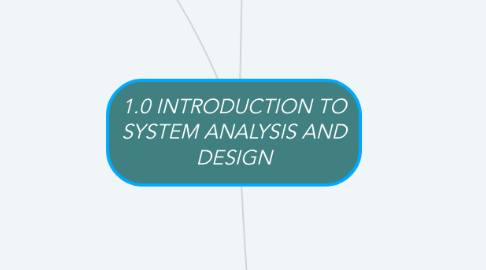
1. 1.3 Understand Project Management
1.1. 1.3.1 Explain project planning, scheduling, monitoring, and reporting.
1.2. 1.3.2 Explain steps in project planning
1.3. 1.3.3 Describe work breakdown structures, task patterns, and critical path analysis.
1.3.1. -Work breakdown structure (WBS) involves breaking a project down into a series of smaller tasks. Clearly identify each task and include an estimated duration
1.3.2. -Tasks in a work breakdown structure must be arranged in a logical sequence called a task pattern.
1.3.3. -Critical path is a series of tasks which, if delayed, would affect the completion date of the overall project. If any task on the critical path falls behind schedule, the entire project will be delayed.
1.4. 1.3.4 Create a work breakdown structure.
1.5. 1.3.5 Explain techniques for estimating task completion times and costs.
1.6. 1.3.6 Explain leadership and project manager.
1.6.1. -Good leadership is essential in building up an information system project
1.6.2. -Project managers typically perform four activities, or functions: planning, scheduling, monitoring, and reporting
2. 1.1 Discuss Information System.
2.1. 1.1.1 Define information and information system.
2.1.1. INFORMATION: Data that has been transformed into output that is valuable to users
2.1.2. INFORMATION SYSTEM: Combines information technology, people and data to support business requirements
2.2. 1.1.2 Describe information system components.
2.2.1. HARDWARE
2.2.1.1. Physical layer of information system
2.2.2. SOFTWARE
2.2.2.1. -System software -Application software -Enterprise applications
2.2.3. DATA
2.2.3.1. -Tables store data -Linked tables work together to supply data
2.2.4. PROCESSES
2.2.4.1. Describe the tasks and business functions that users, managers, and IT staff members perform to achieve specific results
2.2.5. PEOPLE
2.2.5.1. - Stakeholders - Users, or end users
2.3. 1.1.3 Identify various types of information system
2.3.1. Executives : Executive Information systems
2.3.2. Senior Manager : Decision support systems
2.3.3. Middle Managers : Management Information system
2.3.4. Workers : Transaction Processing systems
3. 1.2 Discuss system development approach.
3.1. 1.2.1 Explain system development method:
3.1.1. a. Structured Analysis
3.1.1.1. -Traditional systems development technique that is time tested and easy to understand. -Uses a series of phases to plan, analyze, design, implement and support an IS.
3.1.2. b. Object Oriented Analysis
3.1.2.1. -Popular technical approach for analyzing, designing an application, system, or business by applying the object-oriented paradigm and visual modeling throughout the development life cycles to foster better stakeholder communication and product quality.
3.1.3. c. Agile/Adaptive Method
3.1.3.1. Refers to an iterative, incremental method of managing the design and build activities of engineering, information technology and other business areas that aim to provide new product or service development in a highly flexible and interactive manner.
3.2. 1.2.2 Explain System Development Life Cycle (SDLC) activities:
3.2.1. a. Planning
3.2.1.1. -First phase in the systems development process
3.2.1.2. -Identifies whether or not there is the need for a new system to achieve a business’s strategic objectives
3.2.2. b. Analyze
3.2.2.1. -Second phase is where businesses will work on the source of their problem or the need for a change.
3.2.2.2. -Identify the best fit for the ultimate goal(s) of the project.
3.2.3. c. Design
3.2.3.1. -Third phase describes, in detail, the necessary specifications, features and operations that will satisfy the functional requirements
3.2.3.2. -Discuss and determine their specific business information needs for the proposed system
3.2.4. d. Development
3.2.4.1. -Fourth phase is when the real work begins
3.2.4.2. -This phase marks the end of the initial section of the process.
3.2.4.3. -This phase signifies the start of production
3.2.5. e. Testing
3.2.5.1. -Fifth phase involves systems integration and system testing
3.2.5.2. -Verification and validation, both of which will help ensure the program’s successful completion
3.2.6. f. Implementation
3.2.6.1. -Sixth phase is when the majority of the code for the program is written
3.2.6.2. -This phase involves the actual installation of the newly-developed system
3.2.7. g. Maintenance
3.2.7.1. -Seventh and final phase involves maintenance and regular required updates
3.2.7.2. -To make sure that the system won’t become obsolete
3.2.7.3. -Providing latest updates for certain components to make sure it meets the right standards and the latest technologies
3.3. 1.2.3 Describe various types of life cycle models such as:
3.3.1. a. Waterfall model
3.3.1.1. Represents the system in terms of data and the processes that objects that act upon that data.
3.3.2. b. Spiral Model
3.3.2.1. Each iteration, or phase, of the model must have a specific goal that is accepted, rejected, or changed by the user, or client.
3.3.3. c. Iterative and incremental development
3.3.3.1. Develop a system through repeated cycles (iterative) and in smaller portions at a time (incremental), allowing software developers to take advantage of what was learned during development of earlier parts or versions of the system.
3.3.4. d. Agile Model
3.3.4.1. -Newest software development method -Agile methods attempt to develop a system incrementally, by building a series of prototypes and constantly adjusting them to user requirements.
3.3.5. e. Prototyping model
3.3.5.1. -A prototype is an early working version of an information system. -Prototyping tests system concepts and provides an opportunity to examine input, output, and user interfaces before final decision are made.
3.3.6. f. Rapid Application Development (RAD)
3.3.6.1. Team-based technique that speeds up information systems development and produces a functioning information system
3.3.7. g. Joint Application Development (JAD)
3.3.7.1. Popular fact-finding technique that brings users into the development process as active participants
3.4. 1.2.4 Identify appropriate life cycle models based on given scenario
3.5. 1.2.5 Describe project management activities:
3.5.1. a. planning
3.5.1.1. Identifying all project tasks and estimating the completion time and cost of each
3.5.2. b. scheduling
3.5.2.1. Creation of a specific timetable, usually in the form of charts that show tasks, task dependencies, and critical tasks that might delay the project.
3.5.3. c. monitoring
3.5.3.1. Requires guiding, supervising, and coordinating the project team’s workload
3.5.4. d. reporting
3.5.4.1. Includes regular progress reports to management, users, and the project team itself
